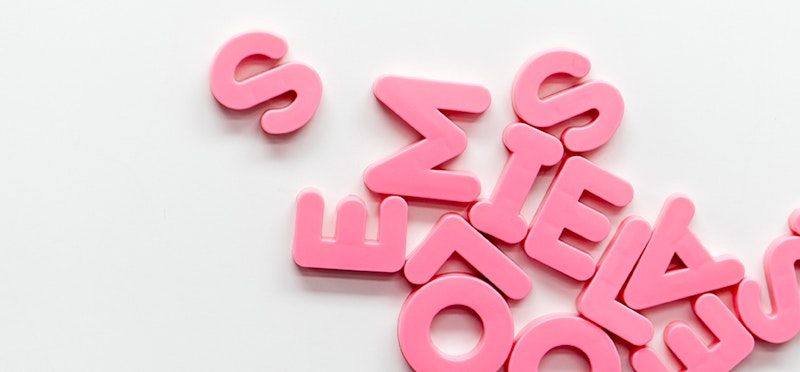
About a third of the younger clients that I worked with had trouble confusing “b” and “d” when reading. Most of them had been told at least one tip for addressing what is commonly called a b and d reversal problem. Around here, making the word bed with both hands out front of them seemed to be the most popular, but the kids would still be having consistent problems with b and d reversals when I started with them.
Over the years, I explained the following method to each of them and, within a week or so, their problem with b/d confusion would be solved, provided they make one significant change in writing behavior. It’s not my own method. I got it from Romalda Spalding’s book, The Writing Road to Reading years ago. It works best if a child is willing to make the writing change, but it will work for reading even if they don’t.
Reading b and d
It’s simple really, and it’s also primarily tactile, so they don’t have to interrupt their reading by putting their hands in the air and they don’t have to switch from thinking about the storyline to thinking about a bed all of a sudden.
You have your child say /b/ (the sound, remember) and then you have him look in a mirror while he says it. Do it yourself also, and point out the straight line (more or less) that your lips make as you press them together to say /b/. Then show him the letter “b” and tell him that as he’s reading along a line of print, when he comes to a “b” he runs into the line first, so he should make the line with his lips, and say /b/.
What about the circle? This one is just a bit tricker. Have your child say /d/ (again, just the sound) and pay attention to his tongue. Ask him if he feels it curled up inside his mouth, the tip pressing against the roof of his mouth. Explain that he’s making a big circle in there, with the tongue making the bottom of the circle and the roof of his mouth the top. To give him a visual, tell him a big gum ball would fit in there perfectly.
Now show him the letter “d” and tell him that when he’s reading along a line of print and comes to the letter with the circle first he should make the circle in his mouth and the /d/ sound will come out.
I’ve had more than one parent return to my office a week later and say something like, “We fought the b/d reversal issue for years, but that worked!” And it doesn’t get in the way of comprehension like most mnemonic methods are likely to do.
Writing b and d
But the great part of this method for dealing with b and d reversals is that it works when writing too, provided you take the time to teach your child to make the letter “d” by starting with the circle first. Most children already write the letter “b” starting with the line, though after that all bets are off on how they’ll do the circle. However, about half of those who struggle with “b” and “d” are writing the letter “d” the same way, by starting with the line. For the writing side of this to work, you have to change that. Spalding has excellent information in her book on forming all the letters, by the way.
Essentially you need to teach your child to form the following letters, preferably in this order: c, o, a, d, g and finally q. Your child forms a “c” starting at about 2 o’clock on a clock face and finishes at 4 o’clock. (This is straight out of Spalding, incidentally.) After the “c” is being properly formed, show your child how to extend the motion to make an “o.” Then extend it further to make an “a,” then even further to make a “d.” Finally, show your child how to extend the “a” into first “g” and then “q.”
So, assuming you’ve got the letters being formed properly, all you now need to do is tell your child that when he’s saying the /b/ sound he should notice that his lips are forming a line as he says it, so write the letter that he starts with a line.
Conversely, if he’s saying the /d/ sound, tell him to notice that he’s forming the circle in his mouth (for the gum ball) and that he should then write the letter that he starts with a circle.
This is primarily tactile, requiring little thought after just a bit of practice, and will become habitual, or automatic behavior, quite quickly if you try it. Just make sure and have your child do a fair amount of writing too so he has a chance to build the habit in the writing direction also.
I repeat, this method for dealing with b and d reversals does work. I have never seen it fail and I needed to use it with about a third of the 200 or so children that I worked with over a ten-year period. Even if I wasn't going to be working with a child, I often taught it during testing if I saw a problem because it is so intuitive that there was a reasonable chance that it would stick, particularly if a parent was present to hear the explanation as well.
If you find this lesson useful and you're working with a struggling reader, consider purchasing the OnTrack Reading Advanced Code Phonics Workbook. The workbook, together with the instruction manual, constitute a complete advanced code phonics program that incorporates most of these Tidbits and covers precisely the information your child will need to become proficient in phonics, including what I believe to be the most effective multisyllable decoding method you will find anywhere. Also, if you try this technique and like it, please link to this page if you have a website, so that others can learn of it. Ms. Spalding came up with it long ago, and it's a shame more children aren’t taught it today because it works so well and is so easy to teach.
Now, if you’re a parent or teacher working with a child who reads with poor fluency, take a look at the Tracking Tip. It might or might not help, but it's always worth trying a couple of times to see, and it takes only a few seconds to implement.




